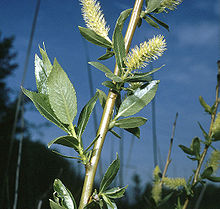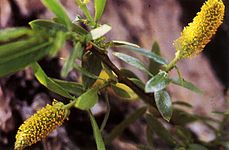
Elaeagnus angustifolia, commonly called Russian olive, silver berry, oleaster, or wild olive, is a species of Elaeagnus, native to western and central Asia, Iran, from southern Russia and Kazakhstan to Turkey, parts of Pakistan and parts of India. As of 2020, it is widely established in North America as an introduced species.

Salix alba, the white willow, is a species of willow native to Europe and western and central Asia. The name derives from the white tone to the undersides of the leaves.

Salix × fragilis, with the common names crack willow and brittle willow, is a hybrid species of willow native to Europe and Western Asia. It is native to riparian habitats, usually found growing beside rivers and streams, and in marshes and water meadow channels. It is a hybrid between Salix euxina and Salix alba, and is very variable, with forms linking both parents.

Salix amygdaloides, the almond leaf willow or peach leaf willow, is a species of willow native to central North America east of the Cascade Range. It can be found in southern Canada and the United States—from western British Columbia to Quebec, Idaho, Montana and Arizona to eastern Kentucky. As of 2022, it is presumed extirpated from the state of Kentucky.

Fragaria chiloensis, the beach strawberry, Chilean strawberry, or coastal strawberry, is one of two species of wild strawberry that were hybridized to create the modern garden strawberry. It is native to the Pacific Ocean coasts of North and South America.

Rubus leucodermis, also called whitebark raspberry or blackcap raspberry, is a species of Rubus native to western North America.

Salix cinerea is a species of willow native to Europe and western Asia.
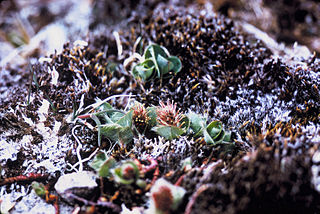
Salix arctica, the Arctic willow, is a tiny creeping willow. It is adapted to survive in Arctic conditions, specifically tundras.

Salix nigra, the black willow, is a species of willow native to eastern North America, from New Brunswick and southern Ontario west to Minnesota, and south to northern Florida and Texas.

Salix lasiolepis is a species of willow native to western North America.

Salix scouleriana is a species of willow native to northwestern North America. Other names occasionally used include fire willow, Nuttall willow, mountain willow, and black willow.
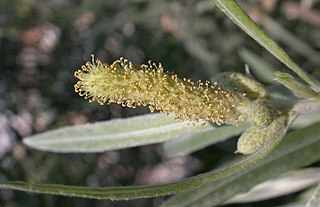
Salix exigua is a species of willow native to most of North America except for the southeast and far north, occurring from Alaska east to New Brunswick, and south to northern Mexico. It is considered a threatened species in Massachusetts while in Connecticut, Maryland, and New Hampshire it is considered endangered.

Betula occidentalis, the water birch or red birch, is a species of birch native to western North America, in Canada from Yukon east to Northwestern Ontario and southwards, and in the United States from eastern Washington east to western North Dakota, and south to eastern California, northern Arizona and northern New Mexico, and southwestern Alaska. It typically occurs along streams in mountainous regions, sometimes at elevations of 2,100 metres and in drier areas than paper birch.

Salix bebbiana is a species of willow indigenous to Canada and the northern United States, from Alaska and Yukon south to California and Arizona and northeast to Newfoundland and New England. Common names include beaked willow, long-beaked willow, gray willow, and Bebb's willow. This species is also called red willow by Native Americans according to The Arctic Prairies Appendix E by Ernest Tompson Seton.

Salix gooddingii is a species of willow known by the common name Goodding's willow, or Goodding's black willow. It was named for its collector, Leslie Newton Goodding.

Salix hookeriana is a species of willow known by the common names dune willow, coastal willow, and Hooker's willow.
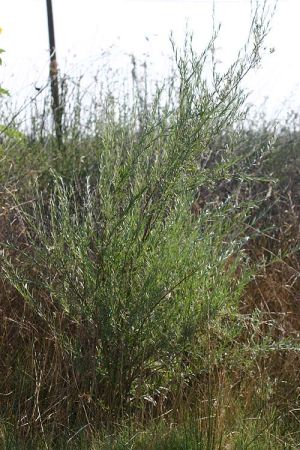
Salix sessilifolia is a species of willow known by the common name northwest sandbar willow. It is native to the west coast of North America from British Columbia and the US states of Washington and Oregon. It grows on sandy and gravelly riverbanks, floodplains, and sandbars.

Salix sitchensis is a species of willow known by the common name Sitka willow.

Salix alaxensis is a species of flowering plant in the willow family known by the common names Alaska willow and feltleaf willow. It is native to northern North America, where it occurs throughout Alaska and northwestern Canada.

Salix commutata, the undergreen willow, is a plant species native to western Canada and the north-western United States. It has been reported from Alaska, Yukon, the Northwest Territories, British Columbia, Alberta, Saskatchewan, Montana, Idaho. Washington and Oregon. It grows on rocky alpine and subalpine slopes, conifer forests, stream banks, bogs, etc.
